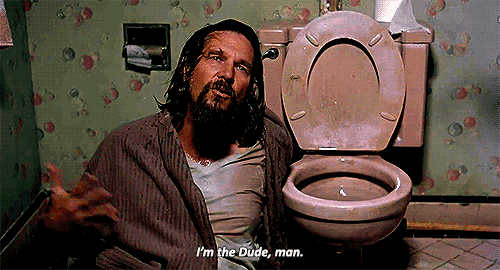
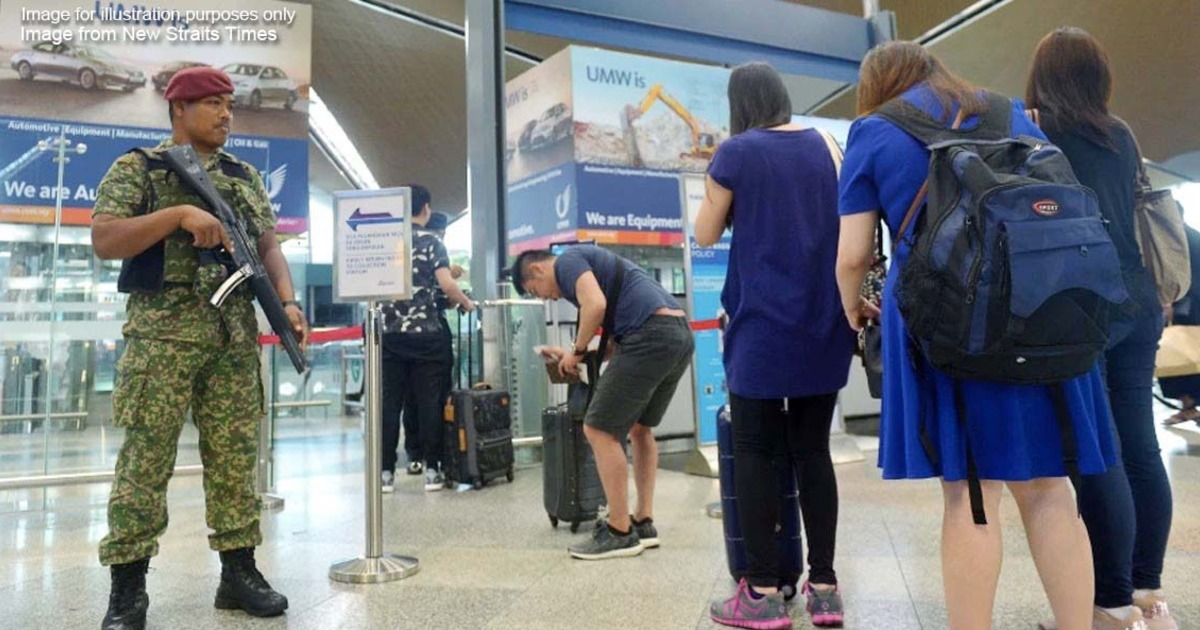
Consumer,General,Sponsored
M'sians who are scared of flying get spot-checked more, and other weird airport stats
almost 6 years ago Sponsored ContentIf you’ve ever travelled with people that you know, you may notice that their behavior might change the moment they step into an airport. Your Manglish-speaking friend may suddenly acquire an American accent, or your usually calm sister may become a prickly ball of stress.
And if you didn’t notice anyone acting differently, perhaps the one who changed is…. you.

But theories aside, we started to wonder how Malaysians actually behave at airports – from toilet habits to security concerns – and so we teamed up with our friends at Cilisos and Soscili to run the first ever Malaysian Kaki Terbang Survey 2019 (Cilisos came up with this name, obviously). It’s essentially a snazzy name for an airport behavior survey that we conducted with Malaysia Airports (MAHB), the people who run 39 airports around Malaysia; most notably the Kuala Lumpur International Airport and its KLIA 2 terminal. Fun fact: KLIA 2 is actually a terminal and not a separate airport. Other fun fact: Most people think Malaysia Airports and Malaysia Airlines are the same company… they’re actually separate unrelated entities.
Before we get into the fun stuff, here are the base results from the survey:
- Survey period: 14th August – 1st Sept 2019
- Total respondents: 3113
- Top locations: Selangor (34%), KL (23%), Sarawak (9%), Sabah (6%), Johor (6%)… but we had respondents from every state
- Top age groups: 21-29 (43%), 30-39 (31%), 40-49 (6%)… but we had respondents from every age group
- Gender identification: 62% female, 37% male, 1% others
Now buckle up and put your seat in the upright position because fun stuff will be landing in 3...2...
1. Paranoid Malaysian travellers are MORE LIKELY to get spot-checked by airport security
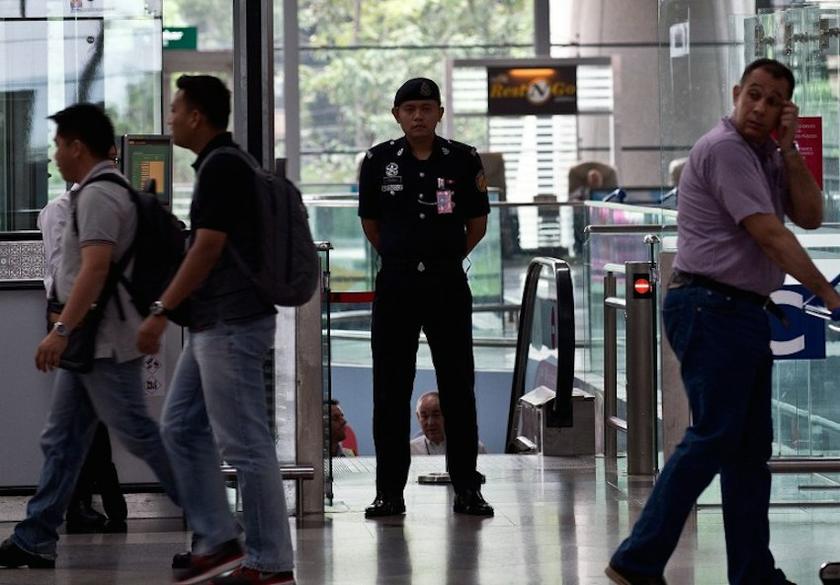
Generally, most Malaysian travellers (46%) think that they’re equally as safe in the airport as any public place, but 37% said they’ll be a little more cautious if a stranger started talking to them. What’s interesting here is that those who said they’re extra-cautious of everything around them were also stopped for random checks by airport security the most (63%) while those who said they were totally not concerned about safety were stopped the least (56%).
This may also be pretty expected, but more men have reported getting stopped (62%) compared to women (56%). After filtering down the results by state, our survey indicates that you’d be more likely to get stopped if you’re from Terengganu (69%) although we’re pretty sure your state of origin won’t be known to security at the time.
Overall though, a majority of Malaysians take these checks in good faith; with 58% understanding that security are just doing their job. That being said, a very insignificant percentage (less than 1%) said they would outrightly refuse to be checked. What’s perhaps funny/worrying about this is that the majority of this 1% would refuse by running away from the officer. DO NOT DO THIS! While it might sound amusing, running away from an officer may drastically escalate the situation and put yourself and others in danger.
But beyond spotchecks and the usual security and immigration counters, there are a whole lot of under-the-hood methods that airports employ to ensure that guests are kept safe and comfortable. For instance, MAHB has something called a ‘High-precision foreign object debris detection system’ (FODDS) at KLIA that uses linear cell radar technology to increase safety on the runway. It can detect even the smallest objects – like a loose grain of rice – on the runway., as small debris can cause major damage to planes, causing bent/broken fan blades, engine failure, fires, wing damage, and even massive puncture on plane tires; and we’re the first in the world to be using this sort of radar after Japan.
2. The thing that annoys travellers the most are……..queue cutters
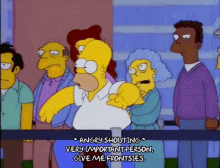
We don’t like them at ATM machines, we don’t like them on the road, and we sure don’t like them at the airport. The top pet peeves listed are:
- People who cut queues (58%)
- Machines (Immigration autogates, self check-in, etc) that don’t work (40%)
- People who rush to board the plane before being called by the attendant (38%)
In case you’re wondering why the percentages exceed 100% when added up, it’s because respondents could pick up to 3 annoyances.
Speaking of queues, our survey showed that most Malaysians spend 11 – 30 minutes to get past immigration, with 56% preferring to use the autogate. On the other hand, 35% prefer to choose their options strategically, by analyzing which queue is moving faster before making a decision.
There’s good news in the horizon in regards to queues though – our friends at MAHB say that they’re working to redesign the immigration checkpoint area at KLIA 2 terminal to address feedback that the current area doesn’t really cater to long queues and it has poor visibility from a distance. MAHB has added 8 new autogates at the arrival area of the KLIA Main Terminal, bringing the total to 28, with more coming in the near future. As for the KLIA 2 terminal, there are currently 30 autogates already in service.
But beyond just increasing the number of terminals, MAHB is also working with partner airlines on implementing facial recognition technology to reduce queues and fast-track your way to the boarding gate. This is called a single token journey and we heard that MAHB will be piloting the initiative by the end of the year.
The importance of making queues move faster and more efficiently is also reflected in our survey, as Malaysians picked fast immigration counters (66%) and clean toilets (60%) as the most important factors for a pleasant airport experience.
Speaking of toilets…
3. The gender that’s more likely to wash toilet seats before using are…...men.
Just like Area 51, the toilets of the opposite gender may be a place of mystery to many of us. Not being able to enter and observe, we can only imagine (or glean from movies) what toilets are like on the other side.
This writer (who is male) was pretty surprised to find that men (34%) were more inclined to wash the toilet seat before use compared to women (31%). However, women (27%) were more inclined to line the toilet seats with tissue paper compared to men (24%).
Overall, though, hygiene seems to be important to many Malaysians regardless of gender. 41% of Malaysians carry wet wipes and 28% carry sanitizers in their bags. Not just that, the toilet is usually the first stop for foreign visitors and paints the first impression of a country’s culture and cleanliness.
This is why the condition of the airport toilets is one of the things strictly monitored under the Quality of Service framework by the Malaysia Aviation Commission (MAVCOM). There has been a massive toilet refurbishment exercise since 2017, with a goal of redesigning 132 passenger toilets. So far, 32 have been refurbished, and the reason why it takes so long is because airport toilets are made for heavy duty use, and piping systems have to be changed to accommodate the new designs.
To keep toilets clean and comfortable, each toilet has one dedicated cleaner stationed there 24/7… but take note that this doesn’t mean you can do your business on the walls just because there’s someone to clean up after you – we’re (likely) not kidding about this as 2% claim that they clean toilet walls before using. This is why MAHB has also started a “Pay It Forward” campaign to remind users to leave the toilet clean and dry for the next user. Yes, it means that adults have to be reminded of basic toilet etiquette, which is both funny and sad if you think about it.
4. Penangites would rather drink free water than pay for food
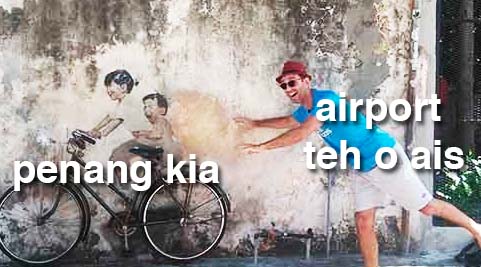
Most travellers would actually end up hitting the F&B outlets while waiting to board their flight. However, 33% pointed out that they would prefer to not spend more than what they would ordinarily pay at an outside branch. On the other end of that spectrum though, 25% said that money isn’t an issue when it comes to airport F&B.
When we further broke down the data by state and income group, we found a couple of interesting things.
In regards to income group, there’s a tie between the groups who said they won’t spend any money on F&B at all… and they’re on opposite ends of each other! Yup, the lowest income group (less than RM2k, 11%) and the highest income group (more than RM50k, 11%) are the least likely to find themselves at an airport cafe.
We already gave this away in the header (belated spoiler alert) but Penangites are the most stingy economically observant of all the states and federal territories. 32% said they wouldn’t pay more at an airport compared to outside, while 12% would just get free water from the dispensers. The most willing to spend? Terengganu-ians. 42% of travellers from Terengganu said that money was no object when it came to food.
4. The most unfortunate thing that happens to Malaysians at an airport is…. getting lost

While missing a flight can be considered a common unfortunate experience – 42% of Malaysians in our survey have missed at least one flight in their lives – a considerable percentage attributed the reason to loss, whether physically getting lost or losing an item/person.
31% have said that they’ve gotten lost in the airport, and 20% of this has resulted in missing a flight. A further 10% have lost a travel buddy, and 18% of them have missed flights while trying to locate their lost friend. While we didn’t include this as a selectable option (hence no percentages) a number of people told us that they’ve lost items at an airport before, with some of them also resulting in a missed flight. Most commonly lost items? Phones and ICs.
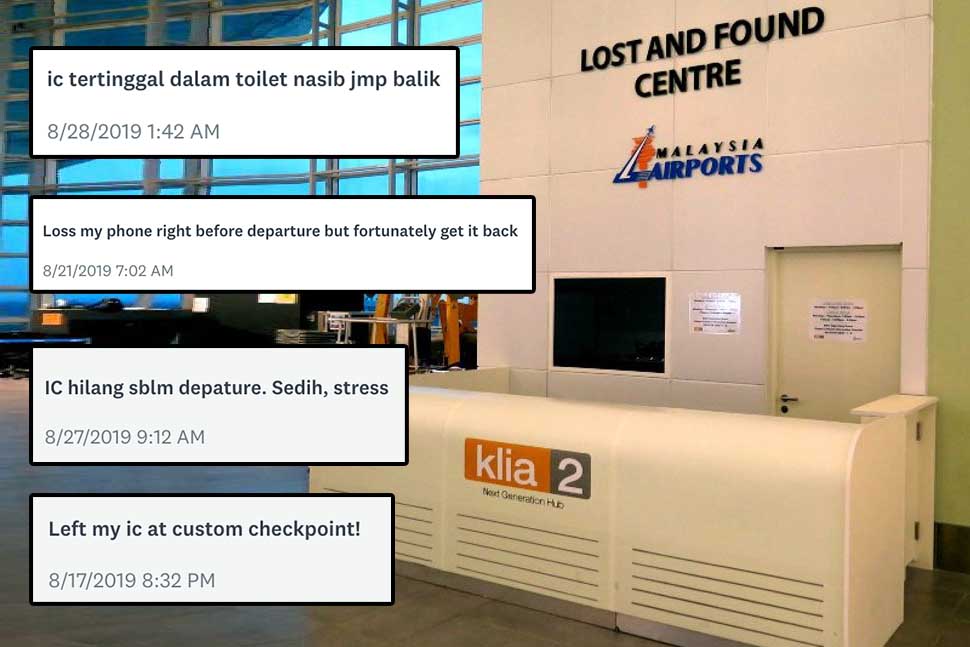
While we can’t really help with lost belongings, there is a solution for the directionally challenged. If you are travelling via KLIA, you can download the MYAirports app that is available on Google Play or App Store to help you with way-finding and also to get real-time flight information. If mobile apps aren’t your thing, then the Airport Digital Directory at the terminal provides similar functions so that you will be able to get to your boarding gate in time without getting lost.
On a less harrowing note, most Malaysians report their airport experience as ‘normal’ with nothing overly bad or exciting happening… but 27% have seen celebrities while 16% have seen couples fighting with each other. 9% have seen someone getting arrested, and 7% witnessing an actual fight. Airports are for flights not fights, okay!
5. First and Business class are more likely to sneak in contraband….and flirt
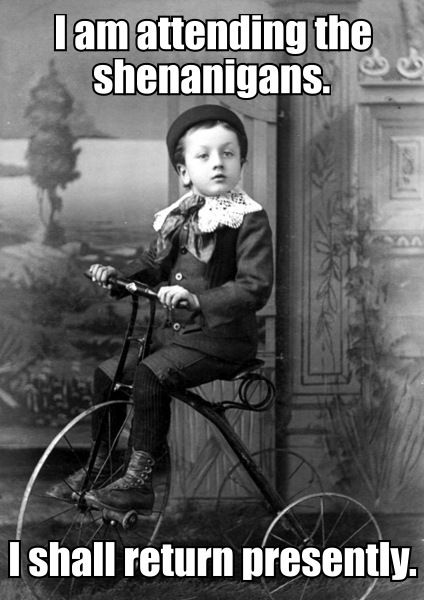
When it came to naughty behavior at the airport, you’d likely be guilty of this top three:
- Checking out the hot flight staff (55%)
- Bringing in heavier luggage than allowed (55%)
- Secretly making fun of foreigners (33%)
However, something of interest popped up when we compared these results against the type of flights they went for; because:
- Those who fly premium class on full service airlines are most likely to sneak in contraband (5%) and flirt with passengers (15%) and flight staff (9%)
- Those who buy premium seats on budget airlines are most likely to try sneaking in luggage that’s above their weight allocation (59%)
- Those who buy Economy class on full service airlines are most likely to make fun of foreigners (37%)
Just a note though…. “contraband” may not necessarily refer to drugs, but stuff that won’t otherwise be allowed in by Customs.
On the social side of things, 5% admitted to falling in love at the airport while 4% said they’ve hooked up with a fellow traveller. For the most part though, we generally keep to ourselves because, when we asked our respondents if they have struck up a conversation with someone cute at the airport, only 18% said yes while 36% have thought about it but never actually went through with the idea. The majority (46%) scolded us for asking that question.
The following stat isn’t exactly naughty, but 11% admitted to putting on a fake accent when they’re at the airport and, strangely enough, most of them are single.
Also, most Malaysians aren’t aware that KLIA has free parking
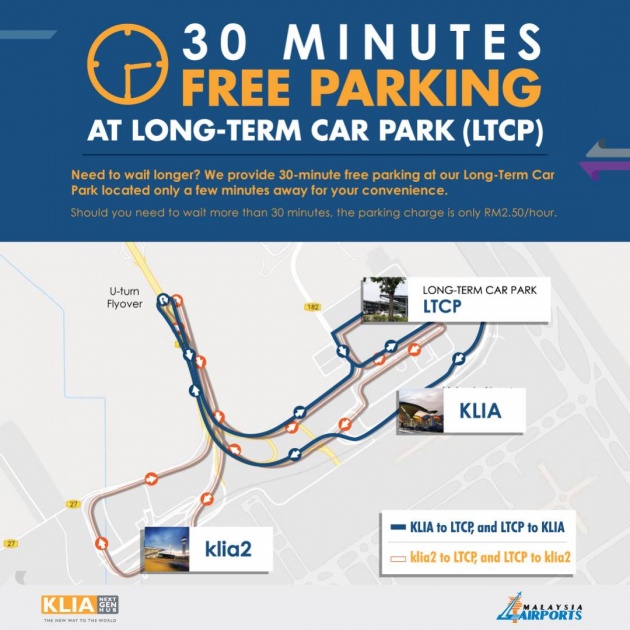
Although a whopping 84% know that KLIA provides free WiFi (and computers), only 21% are aware that KLIA also provides 30 minutes of free parking. This basically gives you enough time to park your car to greet or send off a loved one, or to drop them off at the entrance. Either way, it beats stopping at the side of the road and getting chased off by security!
As mentioned, MAHB is the company in charge of managing, operating, maintaining, and developing most of the airports in Malaysia. However, did you know that they also operate airports in other countries and are one of the largest airport operator groups in the world in terms of number of passengers handled? And speaking of huge volumes of people, no wonder why their strength lies in servicing their guests to make them happy.
There are many things that people think fall under their jurisdiction (few open immigration counters, flight delays, etc) but, as it turns out, an airport is essentially dependent on many parties working together to provide a seamless experience. What they do is to provide the best possible airport infrastructure and facilities for the airlines and government agencies so that they can operate smoothly and, as a result, anyone can have a seamless journey with minimal queues and waiting times.
For guests, this means providing a whole bunch of benefits that even we didn’t know about; such as wheelchairs and baby strollers that can be freely taken and used without the hassle of registering, letting guests freshen up with free shower facilities at KLIA2, and many private nooks and corners for you to relax or snooze on comfy long chairs. Some airports also have faux grass carpet areas, which we’re told is quite a hit among passengers.
And finally, some stats that are too short to turn into full points:
- 10% bring their ‘bantal busuk’ to the airport… That’s almost as many of those who bring religious items and lucky charms.
- Overall, half of our respondents (51%) said that they wouldn’t put any more effort into dressing up for a flight as they would going to the mall.
- 49% will walk on the travelator because it’s faster.
- Those who hate walking the most (ie, standing on the travelator) are mainly from Pahang (34%).
- More than half of Malaysians go for the cheapest seats on a budget airline (52%).
- 15% would stock up on Christmas and birthday gifts from duty free shops… cos cheaper
- Most-purchased duty free items are chocolate (56%) and cologne/perfume (29%)
Also, if you’ve done this survey and are among the 10% who think that KLIA offers free coffee and sandwiches, it’s a trap. However, there are actually some value-for-money places at the airport, if you know where to find them. For example, you can get a very generous serving of nasi campur with chicken and veggies at the KLIA main terminal food court (Level 2) for under RM10. Gateway@klia2, the shopping mall before the klia2 terminal, is also filled with a wide variety of F&B choices. Even convenience stores such as 7-Eleven and Mynews.com have sitting areas just incase you are craving for a bowl of piping hot instant noodles before you fly.
